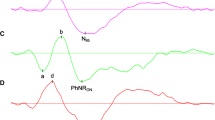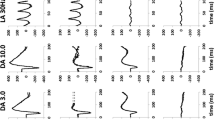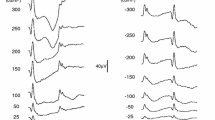Abstract
It is generally accepted that the pattern electroretinogram for very large spatial elements is the result of local luminance stimulation. Responses due to the luminance differences between elements may be assumed to be relatively unimportant because in the case of large elements only few retinal units are stimulated by gradients. With decreasing pattern element size one wonders to what extent the electroretinogram continues to be based on the local luminance stimulation. We investigated this question using 8 Hz checkerboard reversal and compared the pattern recordings with the recordings resulting from the same stimulus field modulated homogeneously (focal electroretinogram). A 100% modulated checkerboard at retinal level may be considerably less modulated because of imperfect optics of the eye. So the pattern electroretinogram should be compared with homogeneous field stimulation of correspondingly lower modulation depth. On the basis of the optical transfer properties of the eye we compared by subtracting the proper focal electroretinogram from the pattern electroretinogram. The difference response was virtually zero for check sizes larger than 120′. For checks from 60′ down the difference response was of the same order of magnitude as the adjusted focal recording. This difference response for eyes with normal optics is largest around 30′; its wave form was found to be rather invariant with check size.
Similar content being viewed by others
References
Maffei I. Electroretinographic and visual cortical potentials in response to alternating gratings. Ann NY Acad Sci 1982; 388: 1–9.
Spekreijse H, Estévez O, van der Tweel LH. Luminance responses to pattern reversal. Doc Ophthalmol Proc Series 1973; 205–11.
Riemslag FCC, Ringo JL, Spekreijse H, Verduyn Lunel HE. The luminance origin of the pattern electroretinogram in man. J Physiol 1985; 363: 191–209.
Arden GB, Vaegan. Electroretinograms evoked in man by local uniform or patterned stimulation. J Physiol 1983; 341: 85–104.
Korth M. Pattern-evoked responses and luminance-evoked responses in the human electroretinogram. J Physiol 1983; 337: 451–69.
Sokol S, Jones K, Nadler D. Comparison of the spatial response properties of the human retina and cortex as measured by simultaneously recorded pattern ERGs and VEPs. Vis Res 23(7): 723–7.
Hess RF, Baker CL. Human pattern-evoked electroretinogram. J Neurophysiol 1984; 51: 939–51.
Korth M, Rix R. Effect of stimulus intensity and contrast on the pattern ERG. Ophthalmic Res 1984; 16: 60–6.
van den Berg TJTP, Boltjes B. The point-spread function of the eye from 0 °–100 ° and the PERG. Doc Ophthalmol 1988; 67: 347–354.
van den Berg TJTP. Importance of pathological intraocular light scatter for visual disability. Doc Ophthalmol 1986; 61: 327–33.
Vos JJ, Walraven J, van Meeteren A. Light profiles of the foveal image of a point source. Vis Res 1976; 16: 215–9.
Vos JJ. Verblinding bij tunnelingangen. I. De invloed van strooilicht in het oog. Rapp 1983; IZF 1873 C-8 TNO, with English abstract.
Campbell FW, Gubisch RW. Optical quality of the human eye. J Physiol (Lond) 1966; 186: 558–78.
Dawson WW, Trick GL, Litzkow CA. Improved electrode for electroreintography. Invest Ophthalmol Vis Sci 1979; 18: 988–91.
Dagnelie G. Pattern and motion processing in primate visual cortex. University of Amsterdam, The Netherlands, Thesis, 1986.
Spekreijse H, Dagnelie G, Maier J, Regan D. Flicker and movement constituents of the pattern-reversal response. Vis Res 25: 1297–1304.
Aulhorn E, Harms H. Ueber die Untersuchung der Nachtfahreignung von Kraftfahrern mit dem Mesoptometer. Klin Monatsbl Augenheilkd 1970; 157: 843–73.
Holder GE. The significance of abnormal pattern electroretinography in anterior visual pathway dysfunction. Br J Ophthalmol 1987; 71: 166–71.
Author information
Authors and Affiliations
Rights and permissions
About this article
Cite this article
van den Berg, T.J.T.P., Boltjes, B. & Spekreijse, H. Pattern electroretinogram can be more than the sum of local luminance responses. Doc Ophthalmol 69, 307–314 (1988). https://doi.org/10.1007/BF00154411
Issue Date:
DOI: https://doi.org/10.1007/BF00154411




